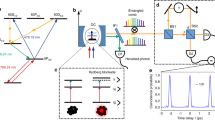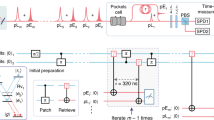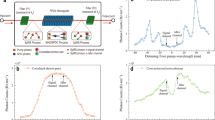Abstract
Entanglement is one of the key features of quantum information and communications technology. The method that has been used most frequently to generate highly entangled pairs of photons1,2 is parametric down-conversion. Short-wavelength entangled photons are desirable for generating further entanglement between three or four photons, but it is difficult to use parametric down-conversion to generate suitably energetic entangled photon pairs. One method that is expected to be applicable for the generation of such photons3 is resonant hyper-parametric scattering (RHPS): a pair of entangled photons is generated in a semiconductor via an electronically resonant third-order nonlinear optical process. Semiconductor-based sources of entangled photons would also be advantageous for practical quantum technologies, but attempts to generate entangled photons in semiconductors have not yet been successful4,5. Here we report experimental evidence for the generation of ultraviolet entangled photon pairs by means of biexciton resonant RHPS in a single crystal of the semiconductor CuCl. We anticipate that our results will open the way to the generation of entangled photons by current injection, analogous to current-driven single photon sources6,7.
This is a preview of subscription content, access via your institution
Access options
Subscribe to this journal
Receive 51 print issues and online access
$199.00 per year
only $3.90 per issue
Buy this article
- Purchase on Springer Link
- Instant access to full article PDF
Prices may be subject to local taxes which are calculated during checkout






Similar content being viewed by others
References
Kwiat, P. G. et al. New high-intensity source of polarization-entangled photon pairs. Phys. Rev. Lett. 75, 4337–4341 (1995)
Kwiat, P. G. et al. Ultrabright source of polarization-entangled photons. Phys. Rev. A. 60, R773–R776 (1999)
Strekalov, D. V. & Dowling, J. P. Two-photon interferometry for high-resolution imaging. J. Mod. Opt. 49, 519–527 (2002)
Santori, C. et al. Polarization-correlated photon pairs from a single quantum dot. Phys. Rev. B 66, 045308 (2002)
Stace, T. M., Milburn, G. J. & Barnes, C. H. W. Entangled two-photon source using biexciton emission of an asymmetric quantum dot in a cavity. Phys. Rev. B 67, 085317 (2003)
Benson, O., Santori, C., Pelton, M. & Yamamoto, Y. Regulated and entangled photons from a single quantum dot. Phys. Rev. Lett. 84, 2513–2516 (1999)
Yuan, Z. L. et al. Electrically driven single-photon source. Science 295, 102–105 (2002)
Ueta, M. et al. in Excitonic Processes in Solids Ch. 3 (Springer, Berlin, 1986)
Itoh, T. & Suzuki, T. Excitonic polariton-polariton resonance scattering via excitonic molecules in CuCl. J. Phys. Soc. Jpn 45, 1939–1948 (1978)
Hönerlage, B. et al. The dispersion of excitons, polaritons and biexcitons in direct-gap semiconductors. Phys. Rep. 124, 161–253 (1985)
Kuwata, M., Mita, T. & Nagasawa, N. Polarization rotation effects associated with the two-photon transition of Γ1 excitonic molecules in CuCl. Opt. Commun. 40, 208–211 (1982)
Savasta, S., Martino, G. & Girlanda, R. Entangled photon pairs from the optical decay of biexcitons. Solid State Commun. 111, 495–500 (1999)
Shimano, R., Svirko, Y. P., Mysyrowicz, A. & Kuwata-Gonokami, M. Efficient two-photon light amplification by a coherent biexciton wave. Phys. Rev. Lett. 89, 233601 (2002)
Saba, M. et al. High-temperature ultrafast polariton parametric amplification in semiconductor microcavities. Nature 414, 731–735 (2001)
James, D. F. V., Kwiat, P. G., Munro, W. J. & White, A. G. Measurement of qubits. Phys. Rev. A 64, 052312 (2001)
White, A. G., James, D. F. V., Munro, W. J. & Kwiat, P. G. Exploring Hilbert space: Accurate characterization of quantum information. Phys. Rev. A 65, 01230 (2001)
Munro, W. J., Nemoto, K. & White, A. G. The Bell inequality: a measure of entanglement? J. Mod. Opt. 48, 1239–1246 (2001)
Boto, A. N. et al. Quantum interferometric optical lithography: exploiting entanglement to beat the diffraction limit. Phys. Rev. Lett. 85, 2733–2736 (2000)
Walter, P. et al. De Broglie wavelength of a non-local four-photon state. Nature 429, 158–161 (2004)
Mitchell, M. W., Lundeen, J. S. & Steinberg, A. M. Super-resolving phase measurements with a multiphoton entangled state. Nature 429, 161–164 (2004)
Acknowledgements
We thank M. Hasegawa for his help in preparing samples. K.E. is grateful to P. G. Kwiat, M. Kuwata-Gonokami and H. Ishihara for discussions. This work was supported in part by the programme “Strategic Information and Communications R & D Promotion Scheme” of the Ministry of Public Management, Home Affairs, Posts and Telecommunications of Japan.
Author information
Authors and Affiliations
Corresponding author
Ethics declarations
Competing interests
The authors declare that they have no competing financial interests.
Rights and permissions
About this article
Cite this article
Edamatsu, K., Oohata, G., Shimizu, R. et al. Generation of ultraviolet entangled photons in a semiconductor. Nature 431, 167–170 (2004). https://doi.org/10.1038/nature02838
Received:
Accepted:
Issue Date:
DOI: https://doi.org/10.1038/nature02838
This article is cited by
-
Creating heralded hyper-entangled photons using Rydberg atoms
Light: Science & Applications (2021)
-
On-demand generation of indistinguishable polarization-entangled photon pairs
Nature Photonics (2014)
-
Polarization-entangled photons produced with high-symmetry site-controlled quantum dots
Nature Photonics (2010)
-
An entangled-light-emitting diode
Nature (2010)
Comments
By submitting a comment you agree to abide by our Terms and Community Guidelines. If you find something abusive or that does not comply with our terms or guidelines please flag it as inappropriate.



